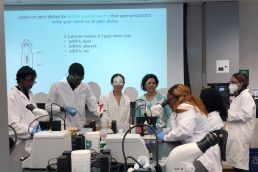Professor Ritu Sarpal organized a two-day Biology workshop, on Apr 15 and Apr 29, for Black high school students enrolled in the Pursue STEM program in her role as Professor and as a member of CSB EDI committee.
Pursue STEM supports Black high school students interested in STEM fields, and is delivered in partnership with Leadership by Design (LBD), the University of Toronto Office of Student Recruitment, and other Departments within our Faculty of Arts and Sciences.
The workshops were designed to give students a flavor for ongoing cutting-edge research in Biology.
Two-headed flatworms
Professor Sarpal gave a talk on stem-cell mediated regeneration and how planarian flatworms serve as a great model system for studying this process.
For their laboratory work, students used wild type flatworms and experimental flatworms in which a gene called β-catenin was turned down using the dsRNA approach. Students cut their worms on the first day, and then examined the regenerated worms on their second visit two weeks later.
They were extremely excited to see that a piece of the wildtype worm missing both a head and a tail was able to regrow a completely new head and tail in just two weeks.
An even more exciting result for the students was to find that a similar piece obtained from worms lacking β-catenin grew two new heads instead of a head and a tail, highlighting the role of this gene in controlling regeneration.
Hungry roundworms
In a workshop led by Professor John Calarco and PhD student Kailynn MacGillivray (Saltzman lab), students learned about a tiny roundworm called C. elegans. This model organism, affectionately known as ‘the Worm’, is widely used in Biology due to its versatility in genetic studies.
Calarco presented a short seminar highlighting the features of C. elegans. The students then acted as geneticists, observing different strains of normal and ‘mutant’ worms and taking notes on their appearance and behaviour.
In a second module, students were asked to time and ‘track’ normal and mutant worm behaviour as these animals foraged towards a food source.
At the end of the workshop, MacGillivray and Calarco held a Q and A session to address any questions from the students about undergraduate and graduate studies in the life sciences at UofT, as well as other questions surrounding career decisions.
When asked to comment about their workshop experience, students wrote:
- “Enjoyable! It made me want to learn more about the regenerative properties of different species and how it can be applied in medicine.”
- “I enjoyed the workshop, it was fun learning about regeneration and questioning if other animals regenerate too. It was my first lab experience and it made me want to have more.”
- “I was not a fan of Biology as I believed it to be less useful than the other two sciences. However, with this workshop I was able to see how broad biology is in terms of species, treatments, experiments and molecular functions. I now want to see how regeneration plays a role in humans especially the eye.”
“It was great to see that such workshops can create a lot of enthusiasm for biology among the high school students,” said Professor Sarpal. “I’d like to thank our graduate students Rebecca Tam and Kailynn MacGillivray, and teaching lab staff Lisa Matchett, Reta Aram, and Pui Tam, for their invaluable assistance with the workshops.”

